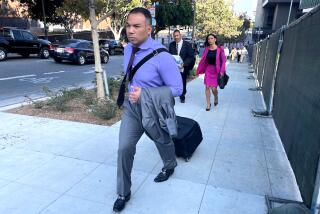Wells Fargo Express Was Unwitting Financier for Pancho Villa
- Share via
BERKELEY — Wells Fargo Express unwittingly helped bankroll Francisco “Pancho” Villa, turning him from a bandit and minor revolutionary into a military threat to both Mexico and the United States, a researcher says.
The story dates from 1913 when Villa and his forces held up a Wells Fargo Express train in Mexico and made off with 122 bars of silver, said Walter Brem, curator at the University of California’s Bancroft Library.
A ransom arranged by an agent for the shipping company was paid for the silver, coming at a critical point in Villa’s life. At the time, he had only a few men under his command. The money allowed him to assemble his powerful “Division of the North,” Brem said.
“This is a real find,” said Brem, who recently discovered the significance of letters donated to the library by a private collector. “It’s a real smoking gun.”
Fredrich Katz, a University of Chicago professor and author of “The Life and Times of Pancho Villa,” agreed.
“It was well known that he held up the train and later bought arms and ammunition,” he said in a telephone interview. “But Wells Fargo’s role was not known. That is new.”
The documents include letters written by Wells Fargo Express employees about the April 9, 1913, robbery in Chihuahua, Mexico.
One letter from the Wells Fargo shipping subsidiary in El Paso, Texas, details Villa’s attack, during which he and 25 of his 200 rebels boarded the train and made off with the silver.
“They also took one of the passengers off the train and killed him in a most cruel way, torturing and mutilating him horribly,” one letter said.
The documents, obtained from a private dealer in Los Angeles, supplement the school’s already extensive holdings on the Mexican Revolution, which include about 120 letters and telegrams from Villa during the years 1913 to 1923.
Villa agreed to return the bullion in exchange for $50,000 cash, paid in pesos by the mining companies that owned the silver, the letters reveal. The silver was worth nearly $160,000 in 1913.
Villa had found it impossible to sell the silver contraband, Brem said.
“What happens when a revolutionary knocks over a train and steals a load of silver?” Brem asked. “What is he going to do with the stuff?”
Brem suspects the shipping company didn’t go public with the deal so it wouldn’t be seen as aiding a revolutionary and so others wouldn’t copy Villa.
The letters stress that the Wells Fargo workers “have been careful not to compromise the company in any way.” Wells Fargo & Co. historian Bob Chandler said that they had merely arranged meetings between Villa and the owners of the purloined silver.
“Wells was just acting as a go-between. It’s not a question of covering it up; we were just the agent,” said Chandler, who also noted that the bank had no role in the affair, since the shipping company had become a separate company in 1905.
Brem said Villa ultimately gave back only 93 of the missing silver bars, claiming the others were stolen by his men.
By 1914, the Division of the North had won a string of important victories.
Two years later, Villa crossed the border with about 600 men and attacked Columbus, New Mexico.
“This was really when he was in decline,” Brem said.
Stores were looted, buildings were burned and 18 Americans, along with at least 90 Villista riders, were killed.
The 1916 raid resulted in an 11-month-long expedition led by U.S. Gen. John Pershing, in which about 10,000 American troops pushed 500 miles into Mexican territory in an unsuccessful attempt to hunt down Villa.
Villa’s troops had helped Francisco Madero overthrow Mexican dictator Porfirio Diaz. After Madero was assassinated, Villa, who had been considered friendly to the United States, was enraged when the United States threw its support behind rival Venustiano Carranza.
After the overthrow of Carranza in 1920, Villa formed a truce with the new government by laying down his arms in exchange for land and amnesty. He then retired to a ranch near Parral, Chihuahua, where he was assassinated by political enemies in 1923.
More to Read
Sign up for Essential California
The most important California stories and recommendations in your inbox every morning.
You may occasionally receive promotional content from the Los Angeles Times.













